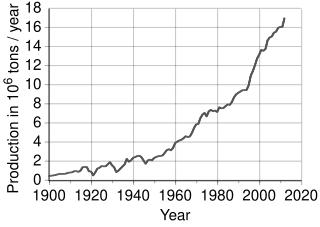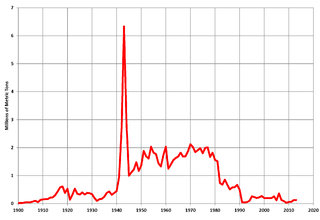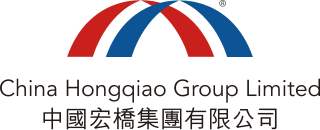The economy of Suriname was largely dependent upon the exports of aluminium oxide and small amounts of aluminium produced from bauxite mined in the country. However, after the departure of Alcoa, the economy depended on the exports of crude oil and gold. Suriname was ranked the 124th safest investment destination in the world in the March 2011 Euromoney Country Risk rankings.

Iron ores are rocks and minerals from which metallic iron can be economically extracted. The ores are usually rich in iron oxides and vary in color from dark grey, bright yellow, or deep purple to rusty red. The iron is usually found in the form of magnetite (Fe
3O
4, 72.4% Fe), hematite (Fe
2O
3, 69.9% Fe), goethite (FeO(OH), 62.9% Fe), limonite (FeO(OH)·n(H2O), 55% Fe) or siderite (FeCO3, 48.2% Fe).

The Riau Islands is a province of Indonesia. It comprises a total of 1,796 islands scattered between Sumatra, Malay Peninsula, and Borneo including the Riau Archipelago. Situated on one of the world's busiest shipping lanes along the Malacca Strait and the Natuna Sea, the province shares water borders with neighboring countries such as Singapore, Malaysia, and Brunei. The Riau Islands also have relatively large potential mineral resources and energy, as well as marine resources. The capital of the province is Tanjung Pinang and the largest city is Batam.

Bintan Island or Negeri Segantang Lada is an island in the Riau archipelago of Indonesia. It is part of the Riau Islands province, the capital of which, Tanjung Pinang, lies in the island's south and is the island's main community.

Mining in Australia has long been a significant primary sector industry and contributor to the Australian economy by providing export income, royalty payments and employment. Historically, mining booms have also encouraged population growth via immigration to Australia, particularly the gold rushes of the 1850s. Many different ores, gems and minerals have been mined in the past and a wide variety are still mined throughout the country.

Mining in Iran is still under development, yet the country is one of the most important mineral producers in the world, ranked among 15 major mineral-rich countries, holding some 68 types of minerals, 37 billion tonnes of proven reserves and more than 57 billion tonnes of potential reserves worth $770 billion in 2014. Mineral production contributes only 0.6 percent to the country's GDP. Add other mining-related industries and this figure increases to just four percent (2005). Many factors have contributed to this, namely lack of suitable infrastructure, legal barriers, exploration difficulties, and government control.

Peak copper is the point in time at which the maximum global copper production rate is reached. Since copper is a finite resource, at some point in the future new production from mining will diminish, and at some earlier time production will reach a maximum. When this will occur is a matter of dispute. Unlike fossil fuels, copper is scrapped and reused, and it has been estimated that at least 80% of all copper ever mined is still available.
Despite being a mineral rich country, Cameroon has only recently begun to investigate mining on an industrial scale. Strong metal and industrial mineral prices since 2003 have encouraged companies to develop mines here. The terrain mainly consists of granite-rich ground with areas of ultramafic rocks that are sources of cobalt and nickel. There are also deposits of bauxite, gold, iron ore, nepheline syenite, and rutile. Alluvial gold is mainly mined by artisanal miners.
The mineral industry of Africa is the second-largest mineral industry in the world. Africa is the second largest continent, with 30.37 million square kilometre of land, which implies large quantities of resources. With a population of 1.4 billion living there. For many African countries, mineral exploration and production constitute significant parts of their economies and remain keys to economic growth. Africa is richly endowed with mineral reserves and ranks first in quantity of world reserves of bauxite, cobalt, industrial diamond, phosphate rock, platinum-group metals (PGM), vermiculite, and zirconium.
The mineral industry of Mozambique plays a significant role in the world's production of aluminium, beryllium, and tantalum. In 2006, Mozambique's share of the world's tantalum mine output amounted to 6%; beryllium, 5%; and aluminium, 2%. Other domestically significant mineral processing operations included cement and natural gas.

Bauxite mining in Australia is an economically significant industry both for Australia and globally. The industry focuses on the mining of bauxite, the primary raw material for alumina and aluminium. Australia is the world's largest bauxite producer, producing almost a third of global bauxite.
Tin mining began early in the Bronze Age, as bronze is a copper-tin alloy. Tin is a relatively rare element in the Earth's crust, with approximately 2 ppm, compared to iron with 50,000 ppm.

The Harita Group is an Indonesian business conglomerate owned and controlled by the Lim family. The group's core businesses are in the natural resources sector, which operates throughout Indonesia. Today, the Harita Group has businesses in nickel mining, ferronickel smelters, bauxite mining, alumina refineries, palm oil plantations, shipping, timber, coal and property. After the 2014 government regulations to ban exports of raw minerals, Harita Group and its partners built a $400 million ferronickel smelter and Indonesia's first alumina refinery for $900 million, both of which have been completed and in full operation since 2016. In December 2019, Glencore International became a partner of Harita Group via its share sale and rights issue of Indonesian-listed Cita Mineral. In June 2021, Harita commissioned the first HPAL plant in Indonesia, which produces Mixed Hydroxide Precipitate, a raw material for electric vehicle batteries. The project had an estimated cost of $1 billion. The current CEO of Harita Group is Lim Gunawan Hariyanto.

Zinc mining in the United States produced 780,000 tonnes of zinc in 2019, making it the world's fourth-largest zinc producer, after China, Australia, and Peru. Most US zinc came from the Red Dog mine in Alaska. The industry employed about 2,500 in mining and milling, and 250 in smelting.
The 2015–16 Kuantan bauxite disaster is an ecological disaster which occurred from 2015 to 2016 onwards in Kuantan District of Pahang in Malaysia. The unscrupulous bauxite mining was blamed for causing soil pollution particularly along the lane of Kuantan highway where the lorries carrying bauxite which also spread to waters around the district, causing the environment to turn red as a result from unregulated mining activities that posed health hazards to both mine workers and the district surrounding communities lived along the mine routes.
Mining in Guyana is a significant contributor to the economy owing to sizable reserves of bauxite, gold, and diamonds. Much of these resources are found in Guyana's Hilly Sand and Clay belt, a region that makes up 20% of the country.

Bauxite mining in the United States produced an estimated 128,000 metric tonnes of bauxite in 2013. Although the United States was an important source of bauxite in the early 20th century, it now supplies less than one percent of world bauxite production.

Mining is one of the main industries in Malaysia. Malaysia produces aggregate, bauxite, clay, coal, copper, feldspar, gold, gravel, ilmenite, iron ore, kaolin, limestone, mica, monazite, sand, silica sand, struverite and tin.

China Hongqiao Group Limited is a company founded in 1994 that specializes in the production of aluminium. Hongqiao is currently the second largest aluminium producer in the world after Chinalco. It is listed on the Hong Kong Stock Exchange with stock code 1378, and is incorporated in George Town, Cayman Islands.
Nickel mining in Indonesia began with small-scale exploratory mining operations during the Dutch East Indies era and began to expand in the 1960s. Most of Indonesia's proven nickel reserves are located in the islands of Sulawesi and Halmahera, and the country has the largest annual production and reserves of nickel in the world.












